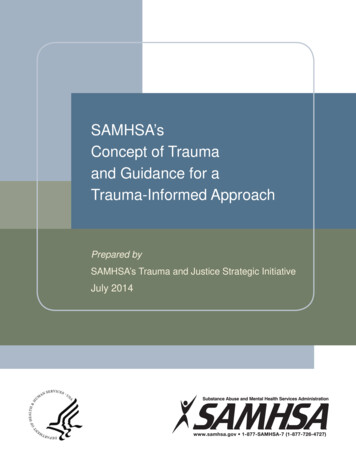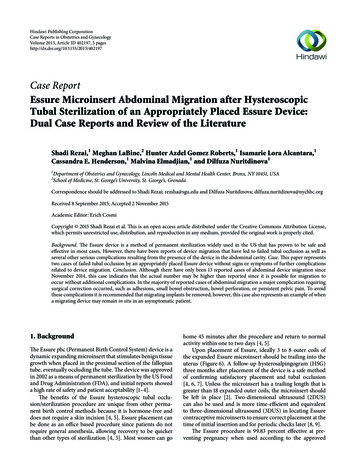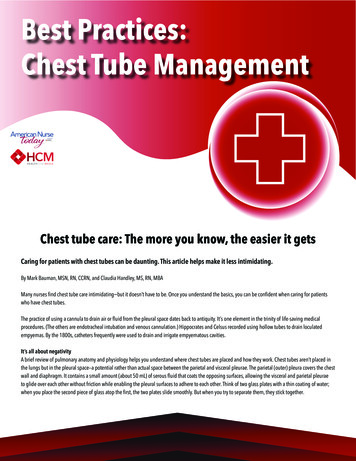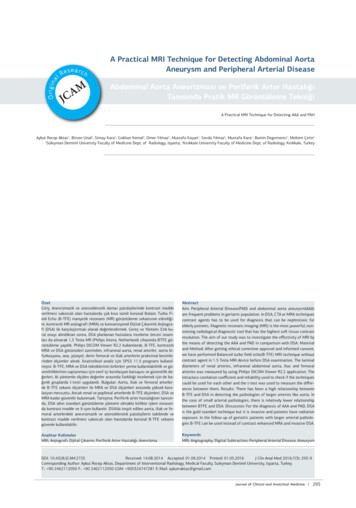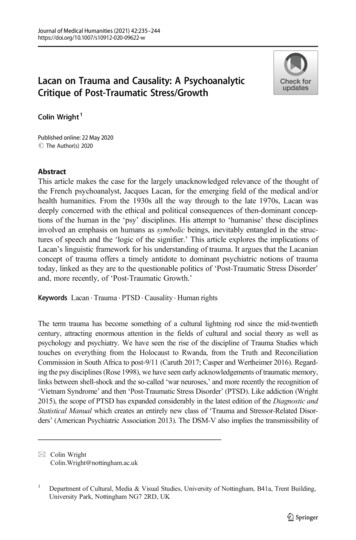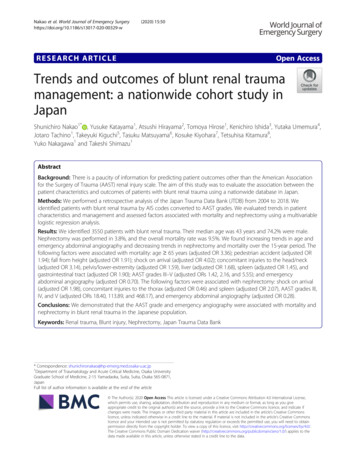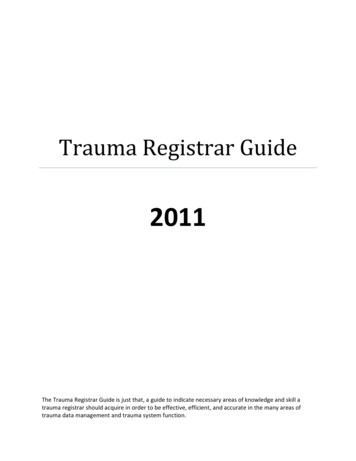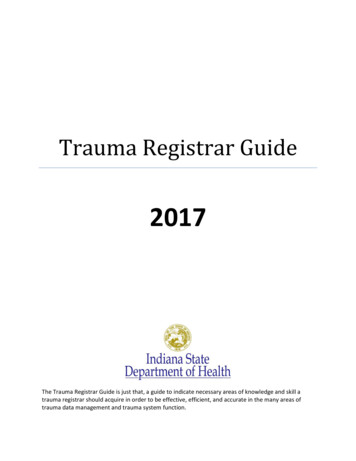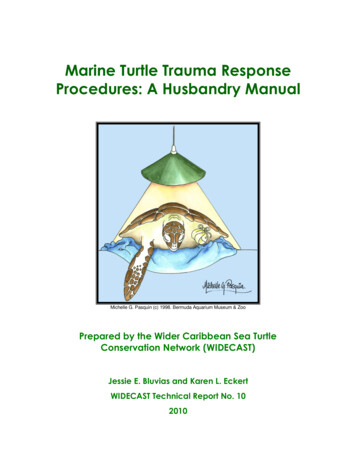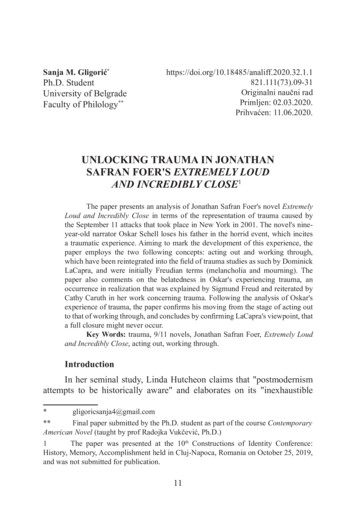
Transcription
Chest and Abdominal Trauma Case StudiesCase #1Scenario: EMS is dispatched to a 2-car MVC with head on collision. The posted speed limit is marked at 40 MPH.Upon EMS arrival to the scene an unrestrained adult driver is found inside the vehicle with noted steering wheeldeformity. The patient is A & O X 3 but appears restless and agitated.On assessment the following is noted:Airway:PatentBreathing:RR: fast; labored with asymmetric chest expansion and use of accessory muscles but no paradoxicalmovement; left side appears hyperinflated and does not move. Breath sounds absent on left,diminished on right; no adventitious sounds. No open wounds; trachea midline. SpO2 86%, EtCO227.Circulation:JVD present; radial pulses absent; carotid pulses fast, weak and thready; equal bilaterally. C / Osevere chest pain & difficulty breathingDisability/LOC:Eyes open spontaneously, pt is awake, alert & oriented to voice & is able to move all extremities tocommand; PERL, EMS notes an abrasion to L anterior chest; the pt is A & O but restless & agitated.Pain:9/10VS:BP 84/60, P 116, R 24Questions1.What two immediate life-threats should besuspected based on this presentation?2.Which one is most likely based on themechanism of injury? What is thepathophysiology and the classic clinicalfindings of this injury?3.What is the mechanism of death in thisinjury?4.What temporizing life-saving procedure mustbe performed immediately?5.What equipment will you need?6.What landmarks must you find?7.At what angle is insertion performed?If you hit bone, should you go over or under?Why?8.What should happen after penetration intothe pleural space?9.Will this procedure re-expand the collapsedlung? Why or why not?10.What is the difference between a simplepneumothorax and a tension pneumothorax?Answers
Chest and Abdominal Trauma Case StudiesNWC EMSS CE November 2015Page 2Case #2Scenario: EMS is dispatched for an adult who fell. Upon arrival to the scene, a neighbor greets you and states thatthey saw the person cleaning gutters earlier. EMS sees an adult pt (50 M) lying on cement driveway supine outsidehome. Upon scene size up a ladder is found on the ground outside a 2 story ( 20 ft.) family home; bushes in frontappear damaged. Upon arrival to the pt, EMS finds a person as stated with bleeding from left forehead; 10” diam ofblood on ground and appears in distress moaning and localizes pain.On primary assessment you note the following:Airway:Gurgling sounds noted in airway w/ bloody secretionsBreathing:Breathing faster than normal, shallow and labored effort (diminished BS on L side).Circulation:Pulse is fast and regular; but radials are weak. Capillary refill is 3 seconds. Neck veins are flat andskin is dusky, cool and moist to the touch.Disability/LOC:Eyes are open to pain, incomprehensible sounds made & localizes to painful stimuli. Pupils PERL;blood glucose level is 86.Pain:8/10Secondary assessment:VS:BP 94/64, P 116, R 24Head:airway clear w/ suctioning; no bruising to face.Pupils:PERLNeck:JVD, trachea midlineChest:abrasion & tenderness L lat area; distress; crepitus to palp w/paradoxical movementAbdomen:abrasion noted to the LUQ/L flank area; pt moans to palpationPelvis:unremarkableExt:L LE w/deformity; otherwise movement x 4Questions1.What 3 chest injuries should be suspectedbased on this presentation and mechanism ofinjury?2.What is the most likely chest injury based onthe mechanism of injury and pt presentation?3.What is the definition for that injury?4.What are the other injury concerns based onpt presentation?5.What criteria is needed for the pt to beplaced on CPAP?6.Once treatment includes CPAP, what area ofre-assessment if key?7.Where should this pt be transported based onpresentation and injury?Answers
Chest and Abdominal Trauma Case StudiesNWC EMSS CE November 2015Page 3Case #3Scenario:. EMS is called to a house for an adult with chest pain from a penetrating injury. PD is on scene stating thatthe scene is safe and that there was an attempted home burglary in which the burglar stabbed the homeowner in anattempt to escape scene. Upon entering the house, the pt is sitting on the sofa holding his chest in distress. The tshirt is noted to have a minor amount of bright red blood in a circular fashion to the slight L of lateral position midchest. He states that his chest feels like there is a burning sensation and is in respiratory distress. No penetratingobjects remain.On primary assessment you note the following:Airway:Breathing:PatentDyspneic; RR rapid, shallow and labored with no movement of L lateral chest wall; breath soundsabsent bilaterally. RA SpO2 89%; EtCO2 30Circulation:Radial pulses becoming non-palp w/ inspiration, carotids fast, weak and thready. Skin is dusky, cool& clammy. No uncontrolled hemorrhage but bubbling to chest wound, JVDeyes open spontaneously; voice is oriented and moves extremities to commands. Pupils are PERL.LOC:Secondary assessmentVS:BP: 96/72; P: 136; RR: 32 shallow and labored. Pt states “I can’t catch my breath.”HEENT:airway remains open; no DCAP-BTLS-TIC PMS to head or neckNeck:Trachea is midline; jugular veins flatChest:1 ½” opening over left medial chest wall; pain on palpation with blood bubbly w/resps.Heart sounds muffled.Abdomen:Soft and non-tender.Skin:Dusky nail beds; circumoral cyanosis. Cool, pale, diaphoretic.Neuro:GCS 15; PERL; SMV intact X 4Pain:10/10Questions1.What 2 chest injuries should be suspected basedon this presentation and mechanism of injury?2.What are the classic clinical findings of theseinjuries?3.Identify the life threat?4.How should this patient be treated? What lifesaving treatment should be done for theseinjuries?5.What equipment is needed to perform thistreatment?6.What is the ongoing danger to the pt from thisinjury? What is the mechanism of death?7.What should be done if after treatment with BPrising, then the pt again becomes hypotensive?8.Where should this pt be transported based onpresentation and injury?Answers
Chest and Abdominal Trauma Case StudiesNWC EMSS CE November 2015Page 4Case #4Scenario: You are called to a restrained driver in a MVC on expressway. There is 15-20 inches of metal intrusion in atthe dashboard due to a frontal impact. The windshield is broken and the steering wheel is bent. The patient iscomplaining of severe substernal chest pain. He is holding his arm against his chest to splint when he breathes.On primary assessment you note the yspneic; RR rapid, shallow and labored with redness and abrasions to the chest wall; noparadoxical movement, SpO2 90%; Breath sounds present but diminished bilaterally.Radial pulses equal; rapid, weak and thready. Skin pale, cool, clammy.Awake; responds to verbal stimuliSecondary Pain:BP: 92/50; P: 116; RR: 26 and shallowAll WNLTrachea is midline; jugular veins flatContusion over sternum on chest wall; pain noted on palpation.ECG: ST with multi-focal PVCsSoft and non-tender.Cool, pale, diaphoretic.GCS 14; PERL; SMV intact X 49/10Questions1.What chest injuries should be suspected based onthis mechanism of injury?2.Which one would be most likely? Why?3.How should this pt be monitored?4.How should you treat this patient?5.What 2 treatment modalities are indicated if the ptbecomes/remains hypotensive?6.Where should this pt be transported based onpresentation and injury?Answers
Chest and Abdominal Trauma Case StudiesNWC EMSS CE November 2015Page 5Case #5Scenario: A 50 y/o restrained driver of a single vehicle crash who drove off the road and laterally hit into a tree at 40mph on the drivers side. Upon arrival, assessment reveals the car to be a vintage model with only the lap beltavailable. Therefore the patient is slumped sideways in to the center of the vehicle, moaning.On primary assessment you note the abored; rapid rate. Breath sounds normal and equal bilaterally.Radial pulses rapid and weak; skin pale and cool to touch.Eyes closed; responds to verbal stimuli by moaning; not moving extremities to command. PupilsPERL, sluggish to respond.Secondary :BP: 88/54; P: 110; RR: 24.Multiple abrasions to the lateral aspects of the pt’s head with lac to L forehead and bleeding. Pupilsas noted above; bleeding coming from mouth with loose teeth.Trachea midline; jugular veins flat.No injury noted to chest with equal chest expansion; no paradoxical movements. EKG: ST withPVCs.abdominal exam with point tenderness to palpation to R and LLQ with positive guarding andtenderness to palpation (moans and localizes pain).multiple abrasions but no entrapment or extrication needed.Questions1.What abdominal injuries should be suspectedbased on this presentation and mechanism ofinjury?2.Which abdominal injury is the patient atgreatest risk?3.Why? Does this injury to the abdomen createan immediate life-threat?4.How should you treat this patient?5.What is the ongoing danger to the patientfrom this injury?6.Identify 3 internal organs in the LQs that couldbe injured from a low lying lap belt?7.Identify 3 internal organs in the UQs that couldbe injured from a high lying lap belt?8.Where should this pt be transported based onpresentation and injury?Answers
Chest and Abdominal Trauma Case StudiesNWC EMSS CE November 2015Page 6Thoracic Trauma as written for theNWC EMSS Paramedic Education ProgramConnie J. Mattera, M.S., R.N., EMT-PI.Epidemiology of chest traumaA.Incidence1.Chest injuries are common occurrences following blunt and penetrating trauma.2.Isolated chest trauma is uncommon; the majority of these patients will have additionalinjuries.3.Prevention efforts a major key4.Thoracic trauma accounts for ⅓ all trauma admits5.Thoracic injury may involve:a.Chest wallb.Thoracic great vesselsc.Heart, lungs, pleurad.Diaphragm, esophaguse.Trachea and bronchus6.Blunt chest traumaa.Occurs in both rural and urban settingsb.Motor vehicle crashes are responsible for 70-80% of blunt thoracic trauma plusfalls, sports and crush injuries7.Penetrating chest traumaa.Usually associated with an urban settingb.Commonly due to gun shot wounds and knife wounds(1)Low velocity gunshot wounds: Hand guns - 12-25% mortality. Sterile,wound only along track of missile.(2)High velocity gunshot wounds: Military and hunting rifles. Cavitationmay create tissue damage 15 times the diameter of the bullet. All thesewounds will require operative debridement at the hospital.(3)Shot gun wounds: Result in varying wound types depending on pelletsize, choke, and distance from the victim.(4)Stab wounds: 75% of penetrating chest wounds resulting from knives,ice picks, sticks, arrows, portions of automobiles or other projectiles.(5)Impalement injuries8.Isolated chest trauma is uncommon (16%); 84% of these patients will have additionalinjuriesB.Morbidity and mortality1.Thoracic injuries are the second leading cause of trauma mortality occurring in 15-25% ofall trauma-related deaths (about 12,000 per year in the U.S.). Most deaths are secondaryto heart and great vessel trauma causing exsanguinating hemorrhage and respiratoryfailure.2.Thoracic injuries are second only to head trauma in mortality rates. Overall mortality rateis 3% to 18%.3.Chest injuries are often associated with abdominal injuries and are a significantcontributor to fatal outcomes in an additional 25%-50% of cases. They are the leadingcause of preventable trauma death.4.Mechanisms of injury causing death from thoracic traumaa.MVC(1)Account for largest number of trauma deaths(2)Over 50% have one or more drivers legally intoxicated(3)Motorcycle death rate more than 15 times greater then auto crashb.Falls: More than ½ in elderlyc.Penetrating injuries; seen more frequently in urban areas due to violent crimed.Crush injuries
Chest and Abdominal Trauma Case StudiesNWC EMSS CE November 2015Mechanisms of injury: Deceleration, shearing, acceleration, n-deceleration: Skeletal body starts or stops moving more quickly than theinternal organs. This type of motion frequently causes more damage to relatively fixedstructures, (aorta), than to non-fixed organs, such as the heart and lungs.2.Compression: Occurs when the external force applied is greater than the resistance of theskeletal body.D.Basic approach to major thoracic trauma remains unchanged, but the treatment of several injurieshave undergone an evolution in the recent past:1.Pericardial tamponade2.Aortic transection3.Blunt cardiac injury4.Pulmonary contusion and flail chestE.Prevention efforts have the potential to reduce the incidence of thoracic injuries:1.Firearm safety2.Sports training3.Seatbelt use, passive restraint systems4.Decreased speed limits5.Community/legal activity regarding drunk driving, etc.6.Violence prevention education i.e., conflict resolution skillsReview thoracic anatomy from Respiratory A&P and Cardiac A&P lecturesGeneral pathophysiology of chest injuriesA.Impairments in ventilatory efficiency1.Pain restricting chest excursion2.Air or blood entering the pleural space3.Chest wall fails to move in unison4.Ineffective diaphragmatic contractionB.Impairments in gas exchange1.Hypoxia: Results from inadequate O2 delivery to tissues2.Pulmonary ventilation/perfusion mismatch: i.e.- contusion, hematoma, alveolar collapse3.Changes in intrathoracic pressure relationships: tension/open pneumothorax or severehemothorax4.Atelectasis5.Contused lung tissue6.Respiratory acidosis, hypercarbia: most often results from inadequate ventilation causedby changes in intra-thoracic pressure relationships and depressed level of consciousnessC.Disruption of respiratory tractD.Impairments in cardiac output1.Hypovolemia: Inadequate intravascular volume due to blood loss2.Increased intrapleural pressures reduce venous return3.Blood in pericardial sac reduces preload4.Decreased stroke volume due to blunt cardiac injury5.Myocardial valve damage6.Vascular disruption7.Metabolic acidosis: caused by hypoperfusion to tissuesPrimary assessment pearlsA.Clinically evident, immediately life-threatening injuries should be considered, found andresuscitated as soon as a deficit is discovered. AVOID HYPOXIC INJURY.B.If agitation or altered mental status is present, assume that the patient has an airway, breathing,and/or perfusion problem especially if objective criteria support these findings, e.g., decreasedoxygen saturation, change in capnogram, or pulse deficits. Do not initially attribute abnormalfinding to drugs or ethanol abuse until life-threatening problems have been ruled out.C.If cervical spine status is unclear, spine motion restriction must be maintained if a mechanism ofinjury suggests potential c-spine injury.D.Etiology of inadequate ventilations/impaired gas exchange1.Ventilation deficiencies: Pulmonary, musculoskeletal, or neurologicC.II.III.IV.Page 7
Chest and Abdominal Trauma Case StudiesNWC EMSS CE November 2015Diffusion deficiencies: Pulmonary contusion, previous diseaseInspection1.Visually inspect the thorax for appearance, contour, symmetry of excursion, and any grossabnormalities, i.e., deformity, contusions, abrasions, penetrating wounds, bruising,lacerations, subcutaneous or tissue edema, paradoxical movements, retractions, orimpaled objects, etc.2.Determine adequacy of ventilationsa.General respiratory rate, depth; and effort (tachypnea, bradypnea)b.Work of breathing; use of accessory muscles; nasal flaringc.Capnography number and waveform3.Determine oxygenation statusa.Clinical presentation i.e. mental status, skin color (cyanosis of the lips or nailbeds) etc.b.Pulse oximetry (SpO2)4.Neck veinsa.Normal anatomic location of neck veins(1)External jugulars are above the clavicle and cross over thesternocleidomastoid muscles.(2)Internal jugulars run parallel to the sternocleidomastoid muscles nearthe carotid arteries.(3)If a patient is positioned at a 45 angle, the venous pulses should notascend more than one to two cm above the clavicle.b.Markedly distended neck veins occur when blood cannot drain into the rightatria. In the presence of chest trauma, JVD may indicate tension pneumothoraxor cardiac tamponade.5.Observe for the type, amount, and nature of secretionsF.Palpation1.Point tenderness2.Loss of chest wall integrity; instability3.Crepitus; subcutaneous emphysema4.Edema5.Tracheal position: Deviation is difficult to appreciate clinicallyG.Percussion1.Hyperresonance / tympany (pneumothorax)2.Dull or flat tone (hemothorax)H.Listen without a stethoscope for noisy ventilatory efforts, air being sucked in or out of an openchest wound.I.Auscultate immediately if in ventilatory distress; Listen posteriorly, laterally, and anteriorly1.Breath sounds present or absent; unilateral or bilateral deficits2.If decreased, attempt to discern etiology; treat appropriately3.Adventitious sounds: treat during focused exam phase4.Presence of bowel sounds in the chest - may signify a ruptured diaphragmInjuries that must be found at B (Breathing) as they jeopardize ventilations and/or gas exchangeA.Tension pneumothorax1.Etiologya.Results from any of the causes of a simplepneumothoraxb.Damage to lung parenchyma (tissue) usually fromblunt traumac.In ventilated patients, it may occur secondary topositive pressure ventilations resulting in a suddenincrease in intrapulmonary pressure (barotrauma).d.Penetration of pleura by rib fracturee.Tracheobronchial tree injuries from shear forces2.Pathophysiologya.Most commonly occurs from blunt trauma.b.Starts with a simple pneumothorax2.E.V.Page 8
Chest and Abdominal Trauma Case StudiesNWC EMSS CE November 2015Page 9A closed pneumothorax progressively accumulates air within the pleural space oninspiration that cannot escape on expiration, creating a one-way valve.d.This accumulation produces an increase in intrapleural pressure (tension) thatcollapses the lung on the affected side and depresses the diaphragm.e.When pressure in the pleural space exceeds pressure in the atria and vena cavae,they collapse. This creates a mechanical obstruction of blood return to the rightheart resulting in markedly decreased preload and cardiac output –OBSTRUCTIVE SHOCKf.Then Rising intrathoracic pressure depresses diaphragm & shifts mediastinumaway from affected side, further compressing vena cavae & compromising intactlung so opposite side becomes pressured as wellg.Hemodynamic dysfunction produces hypoxia and obstructive shock.h.Life-threatening emergency due to cardiovascular compromise. Must besuspected clinically as soon as possible.3.Assessment – classic findingsa.Inspection(1)Complaint of severe pain with breathing (pleuritic chest pain)(2)Restlessness, severe anxiety, agitation(3)Dyspnea, tachypnea, retractions and other signs of respiratory distress(4)Asymmetric chest movement, hyperdistended hemithorax on theaffected side, bulging of intercostal muscles(5)JVD: Collapse of the superior vena cava and right atrium prevents bloodfrom returning to the right side of the heart producing increased centralvenous pressure. Hypovolemia will prevent JVD.(6)Desaturation and cyanosis (late sign)b.Palpation(1)Tachycardia, weak, thready pulses reflect reduced cardiac output(2)Subcutaneous emphysema in face, neck and upper chest(3)Tracheal deviation (late sign) – Trachea is solidly tethered and does notmove easily above sternal notch. Hard to detect without a chest x-ray.c.Percuss for hyperresonance on affected sided.Auscultation(1)Absent or decreased breath sounds on affected side(2)Distant heart sounds (if mediastinal shift to right)(3)Displacement of apical impulse to left lateral chest wall if shift to the left(4)Hypotension (narrowed pulse pressure)4.Emergency interventions - see lab manuala.Apply oxygen 12-15 L/NRMb.Needle pleural decompression is a temporizingmeasure(1)Equipment needed: 10 g IV catheteror use s commercial device;Chlorhexidine wipe.(2)Procedural steps: Insert needle at a 90ndrddegree angle to
Chest and Abdominal Trauma Case Studies Case #1 Scenario: EMS is dispatched to a 2-car MVC with head on collision. The posted speed limit is marked at 40 MPH. Upon EMS arrival to the scene an unrestrained adult driver is found inside the vehicle with noted steering wheel
